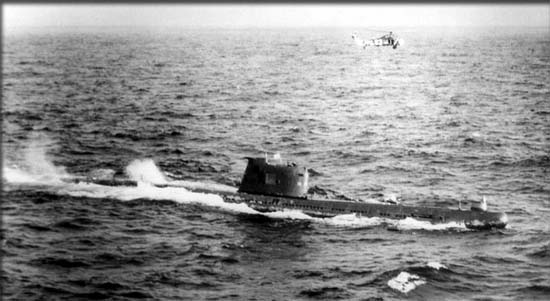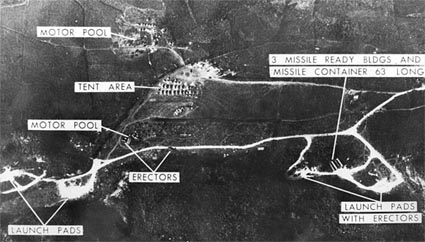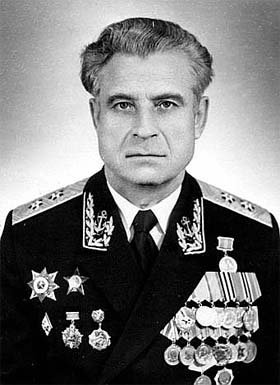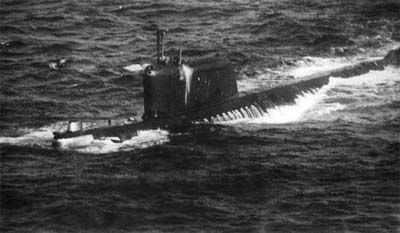pop up description layer
HOME
Cryptozoology UFO Mysteries Aviation Space & Time Dinosaurs Geology Archaeology Exploration 7 Wonders Surprising Science Troubled History Library Laboratory Attic Theater Store Index/Site Map Cyclorama
Search the Site: |
|
Vasili Arkhipov: The Man Who Saved the World
On October 27th, 1962 the world teetered on the edge of a devastating nuclear war. Only the courageous action of a single man, a Soviet submarine commander, acting against the wishes of his shipmates, prevented the nightmare of nuclear holocaust. In the middle of the 20th century two great superpowers arose out of the nightmare of WW II. The United States (US) in the western hemisphere and the Union of Soviet Socialist Republics (USSR) in the eastern hemisphere. Their ideologically opposed economic systems, capitalism and communism, almost guaranteed conflict. Unfortunately their recent acquisitions of nuclear weapons, however, made the danger of such a clash deadly on a previously unimaginable world wide scale. The Cuban Missile Crisis of 1962 In 1962 much of the attention in the superpower conflict, or "cold war," focused on the tiny island of Cuba, only about 90 miles south of Florida. Cuba had long been within the United States sphere of influence, but in 1959 rebel Fidel Castro led a revolution against the authorities and soon established a communist government friendly to the USSR. An aborted invasion by Cuban exiles backed by the United States in 1961 caused further distrust between Cuba and the west. In June of that year USSR leader Nikita Khrushchev agreed to secretly place nuclear tipped missiles in Cuba to deter further harassment. In the beginning of October 1962 a US U-2 spy plane spotted the missiles and the sites that were being built to launch them. Under pressure from the opposing political party in an upcoming election, US president John Kennedy decided to establish a blockade of the island to prevent future delivery of any more of the weapons. He also demanded that Khrushchev remove what was already there. Tensions rose between the two governments and the world feared a devastating nuclear war. Vasili Arkhipov
Vasili Alexandrovich Arkhipov was born on January 30, 1926, to a peasant family near Moscow. At the age of 16 in 1932 he joined the Soviet Navy and was assigned to the Pacific Higher Naval School. After working in WWII on a minesweeper he attended Caspian Higher Naval School and started serving in the USSR's submarines. In 1961 Arkhipov was appointed the executive officer of the Soviet's new nuclear, ballistic missile submarine K-19. The K-19 had been rushed into service and on its maiden voyage a breakdown in the nuclear reactor's cooling system threatened to cause the mechanism to catastrophically "melt down." The crew was forced build an emergency cooling system on the fly. It saved the ship, but the entire crew was exposed to radiation and several members involved in working within the reactor itself, died. This led to unrest among the crew members and a potential mutiny on board the boat. Arkhipov sided with the captain and together they helped calm the crew. The K-19 was later towed back to its home base and repaired. The incident was later dramatized in the movie K-19: The Widowmaker where the part of Arkhipov was played by actor Liam Neelson. The B-59 On October 1, 1962, just before the start of the missile crisis, four diesel-electric submarines left their base on the Kola Peninsula headed to Cuba to support the delivery of nuclear weapons. Leading this flotilla was the B-59. Since the B-59 was the flag ship it carried the flotilla commander: Vasili Arkhipov. In charge of the B-59 itself was its Captain, Valentin Savitsky. He was supported by political officer, Semonovich Maslennikov. The Soviets decided to arm each submarine, in addition to conventional torpedoes, with a single nuclear torpedo carrying a warhead of 10 kilotons - roughly the size of the bomb that had been dropped on Hiroshima during World War II. Moscow had given little orders in regards to the use of this "special weapon." Only that the boat must be under attack and both the captain and the political officer must agree on the launch. After the flotilla of submarines left, the Americans became suspicious that of what was going on in Cuba. An over flight of the island by an U.S. recognizance aircraft on October 14th showed activity on the island that suggested missile bases were being built. Subsequent flights confirmed this and President Kennedy realized he would need to take some action. Kennedy considered using an airstrike to destroy the bases, or invading Cuba and overthrowing Castro. He and his advisors, however, settled on using the U.S. navy to blockade Cuba. On October 23rd Kennedy signed the orders to quarantine the island. No more missiles would be allowed to reach Castro's hands.
Depth Charges On October 27th the U.S. aircraft carrier USS Randolph along with 11 destroyers detected the B-59 on its way to Cuba, and following their orders, tried to enforce the blockade. This meant forcing the submarine to the surface so it could be identified and searched to assure that it carried no nuclear missiles or missile parts. To this end the U.S. vessels started dropping practice depth charges around the B-59 in order to indicate they wished it to surface, not knowing the boat carried a nuclear torpedo. The practice depth charges carried very little explosive as they were meant not to damage friendly submarines during training. The United States had communicated to Moscow that they would be using the practice depth charges for signaling purposes, but somehow this information never made it to the B-59. On board the submarine a heated debate began on what to do next. With the submarine underwater for many days and unable to contact home they were unsure of what was happing on the surface. The sound of depth charges suggested that the USSR was now at war with the United States, however. ''We thought - that's it - the end,''reported Vadim Orlov, a Soviet intelligence officer. With this thought in mind the Captain Savitsky wanted to use the "special weapon" to sink the Randolph. ''We're going to blast them now! We will die, but we will sink them all. We will not disgrace our navy," he declared. The ship's political officer, Ivan Semonovich Maslennikov, concurred. If this had been any of the other submarines in the flotilla that would have been it: The torpedo would have been launched and the aircraft carrier would have disappeared in ball of fire followed by a mushroom cloud. From there it seems almost inevitable that the U.S. response would have involved nuclear weapons. Nuclear Holocaust Despite earlier political rhetoric of a missile gap and the Russians having many more Intercontinental Ballistic Missiles (ICBMs) than the U.S., the actual count of missiles at the time was very much in the favor of the Americans. With Soviet's having made the first nuclear strike at the Randolph, the temptation for the U.S. to strike back might have been too great to resist and the Soviet Union would have been decimated, while only a few atomic weapons would have made it onto American soil. While the Soviet's only had a few missiles that could reach the United States, it did have many that had the range to reach American allies in Europe and it's likely that much of the Britain, France and West Germany would have suffered a nuclear holocaust. The estimated casualties of such an engagment ran into the hundreds of millions. The only thing that prevented this scenario from being happening, however, was Arkhipov's presence on the B-59. He alone felt that since the submarine had been out of contact with Moscow for almost four weeks, they could not be sure of situation on the surface and launching a nuclear weapon was too drastic a measure. According to some sources the argument between the three men was heated and punches were thrown. Eventually Arkhipov calmed Savitsky down. His reputation for bravery during the K-19 incident was said to be key in prevailing in the argument. Ryutik Kertov, commander of the B-4 stated, "Vasili Arkhipov was a submariner and a close friend of mine... He stood out for being cool-headed. He was in control."
Unlike the nuclear powered K-19, the B-59 was powered underwater by using batteries. After the prolonged engagement with the Randolph, the batteries began to run low and the sub's air conditioning started failing. The B-59 was eventually forced to surface and it was only then that the crew learned that the world was not at war and they had nearly initiated a global holocaust. The sub, now having mechanical problems, headed back to the Soviet Union. Despite his heroic actions, Arkhipov was not viewed favorably by his superiors immediately after the incident. Arkhipov, however, continued in Soviet Navy and was eventually promoted to rear admiral in 1975 and vice admiral in 1981. He died in 1998 at the age of 72 from complications of his exposure to radiation during the K-19 incident. What exactly happened during the B-59 incident was not known in the west until after the fall of the Soviet Union. It was only during a conference on the Cuban Missile Crisis in 2002 that details of the story emerged. ''The lesson from this," said Thomas Blanton, director of the National Security Archive, after he heard the story, "is that a guy called Vasili Arkhipov saved the world''. A Partial Bibliography Soviets Close To Using A-Bomb In 1962 Crisis, Forum Is Told by Marion Lloyd, The Boston Globe, October 13, 2002. Thank You Vasili Arkhipov, The Man Who Stopped Nuclear War by Edward Wilson, The Guardian, December 10, 2012. One Minute to Midnight by Michael Dobbs, Vintage, Random House, 2009. Copyright Lee Krystek 2015. All Rights Reserved. |
|
Related Links |
|
|







